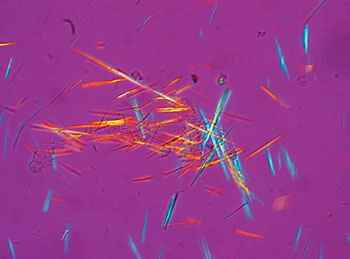Serum Uric Acid Level Associated With Metabolic Syndrome
By LabMedica International staff writers
Posted on 28 Sep 2015
Metabolic syndrome (MetS) is defined by a cluster of risk factors, including obesity, dyslipidemia, hypertension, and insulin resistance, and when occurring together, they increase the risk of developing cardiovascular disease (CVD) and diabetes.Posted on 28 Sep 2015
Serum uric acid is a final enzymatic product of purine metabolism in humans, and it is suggested that hyperuricemia is associated with MetS, and they may have common pathophysiology and in addition to MetS, elevated concentrations of uric acid are associated with a variety of cardiovascular conditions.

Image: Spiked rods of uric acid crystals from a synovial fluid sample photographed under a microscope with polarized light (Photo courtesy of Bobjgalindo).
Scientists at Tehran University of Medical Sciences, (Iran) carried out a case-control study comprised 101 non-smoking individuals, 41 in the MetS group and 60 in the non-MetS group. Blood pressure, fasting plasma glucose, insulin, lipid profiles, uric acid, and anthropometric measures were determined, and body composition was assessed by using bioelectrical impedance analysis (BIA). Homeostasis Model Assessment (HOMA) was used for the assessment of insulin resistance.
Total cholesterol (TC) and TG were determined enzymatically using Parsazmun kits (Tehran, Iran). High density lipoprotein cholesterol (HDL-C) was measured similarly after precipitation with magnesium phosphotungstate. LDL-cholesterol was calculated using Friedewald’s formula. Fasting plasma glucose (FPG was measured using the glucose oxidase method, and immunoreactive insulin (IRI) was measured by radioimmunoassay.
After adjustment for confounding factors, serum uric acid was statistically significantly higher in MetS group at 5.70 ± 1.62 mg/dL than in non-MetS group 4.97 ± 1.30 mg/dL. Subjects in the MetS group had higher anthropometric and blood pressure measurements, body mass index (BMI), lean body mass (LBM), body fat mass (BFM), FPG, insulin, HOMA index, TG, TC, LDL, and lower HDL levels than the subjects in the non-MetS group.
The authors concluded that serum uric acid had independent association with MetS components, and increased the risk of MetS by nearly two-fold. The findings propose that uric acid can be considered as a component of MetS. The study was published on September 15, 2015, in the Journal of Diabetes & Metabolic Disorders.
Related Links:
Tehran University of Medical Sciences
Parsazmun














